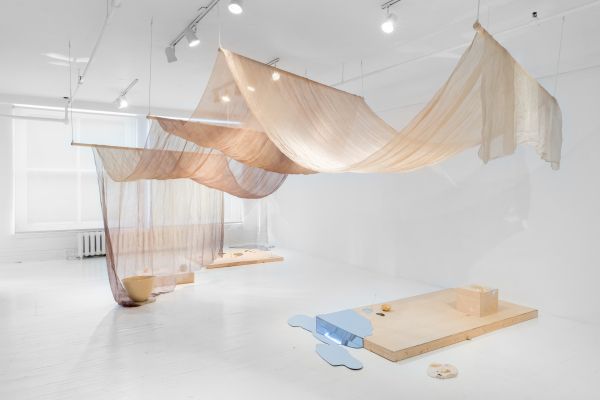It Will Come Like a Wave
- Véronique Sunatori
Véronique Sunatori
It Will Come Like a Wave
The moon is doing her best.
– Shellie Zhang
Véronique Sunatori, a maker of objects and their environments, pays tribute to the historical Japanese crafts of porcelain making, textile dying and woodworking in her pensive installation titled It Will Come Like a Wave. Traces of human presence linger throughout the work – a footprint is seen next to reflecting water, ceramics are evidence of the artist’s hand and local flora remnants are arranged with an intentional yet enigmatic placement. Gold and silver mirrors are offered as gateways and portals to alternative worlds.
The work is the culmination of Sunatori’s recent MFA degree at York University and marks a significant shift in her practice. Sunatori’s earlier work began with creating surreal enclosed objects, taking into consideration the relationship of object to object and between viewer and subject. With It Will Come Like a Wave, the artist has moved into a territory of comfortable ambiguity in the form of an unresolved garden. Sunatori simulates aesthetic and spiritual elements to achieve the appropriate balance between form and emptiness that will enable meditation and stir the imagination.
The artist’s process is evident in her creation of the objects; however in the exhibition, to say there are imperfections would not be an accurate description of Sunatori’s works. While the objects bear resemblance to those created in the traditional Japanese disciplines, Sunatori does not present herself, or strive to be a master craft-maker of these forms. She follows the indications of the object or material at hand, letting the material guide her manipulations, shaping it according to its particular form, while being attentive to the substance’s natural inclinations. The warped bowls, wilting twigs and crinkled fabric stand as evidence of this negotiation – each form is the outcome of an understanding the artist has with the material: working with the object under consideration and not against it.
Sunatori employs her experiential approach further in the layout of the exhibition and asks what possibilities could arise if the negotiations between space/site and object were created with more understanding of the relationships. It Will Come Like a Wave imitates the structure of moon gardens – gardens constructed for optimal viewing of the moon – as an analysis of the Japanese concept of 間 (“ma”) – the ubiquitous presence that exists in between things, an internal or negative space. Within the concept of ma, notions of interior and exterior, here and there, conceive of space and time as reciprocal, collapsing the distinction between them.
In its iteration shown as part of forward motion at the Small Arms Inspection Building in Mississauga, natural light filled all corners of the heritage industrial space. Walking through the exhibition piece, sunlight sparkled on the sheen textile surface and off the mirror reflection pools, while hinting at the work’s presence in various forms. Light and space play a pivotal role in the perception of the work. What details would be illuminated during a morning sunrise? How would the puddles sparkle under moonlight? What colours would form during twilight?
The divisions of night and day, contained and free, are blurred and exist simultaneously as possibilities.
Looming over the installation is a golden, reflective moon that projects the viewer’s gaze right back at them. For centuries, the moon has been a transfixing entity that has obsessed humans, who have longed, mused and dreamed about it: in recent years, it has held colonial undertones as nations race to demonstrate their ability to reach it and surmount humankind’s limitations. A reoccurring subject in her work, Sunatori offers a phenomenological approach to the moon as a figure that has stirred the imagination in a multitude of ways. Although the moon in It Will Come Like a Wave is quite hypnotic, its construction and materials are an indication of its human-made characteristics and our projections onto it.
I imagine Sunatori’s mirror cut moon being eclipsed by the real one as I look up through the skylight of the Small Arms Inspection Building – a reminder of the distinction between human monuments and celestial bodies that will continue far beyond our time.
Her moon avoids grand associations in favour of subjective experiences. In Sunatori’s garden, she offers a moment of pause for epistemological considerations of the moon to arise and for viewers to rediscover something familiar.
– Text by Shellie Zhang
Biography of the artist
Véronique Sunatori is a multidisciplinary visual artist living and working in Toronto, Canada. Sunatori has participated in residencies at AIRY Yamanashi (Japan) and the Société d’art et d’histoire de Beauport (Québec). She is the recipient of the Research and Creation grant for emerging artists from the Conseil des Arts et Lettres du Québec. Sunatori’s work has been presented at Art Mûr, FOFA Gallery, Art Gallery of York University (AGYU) and Small Arms Inspection Building. She holds an MFA in Visual Art from York University (2018).
Biography of the autor
Shellie Zhang (b. 1991, Beijing, China) is a multidisciplinary artist based in Tkaronto/Toronto, Canada. She has exhibited at venues including WORKJAM (Beijing), Scope Art Fair (Switzerland) and Public House of Art (Netherlands). She is a recipient of grants such as the RBC Museum Emerging Professional Grant, the Toronto Arts Council’s Visual Projects grant, and the Canada Council’s Project Grant to Visual Artists. Recent projects include a residency at the Art Gallery of Ontario, the Creative Time Summit, and publication with the Art Gallery of York University (AGYU).
















